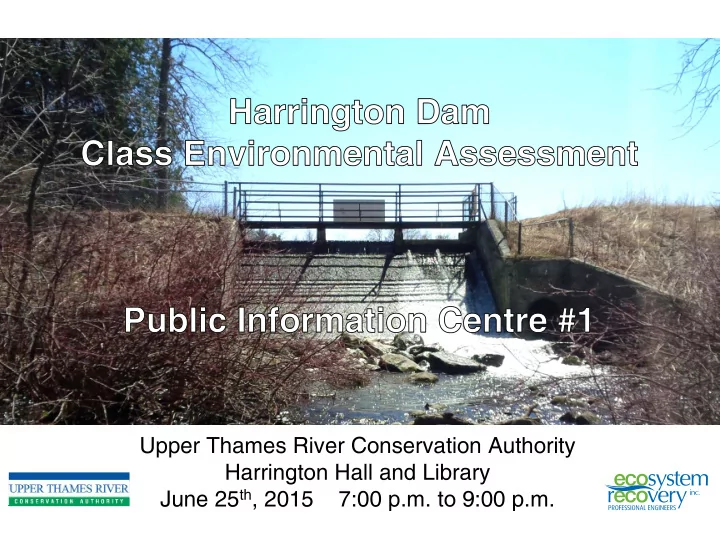

Upper Thames River Conservation Authority Harrington Hall and Library June 25 th , 2015 7:00 p.m. to 9:00 p.m.
Harrington Dam Study Area Harrington Dam was acquired by UTRCA in 1952, and the dam was repaired and the pond enlarged shortly after the structure was acquired. The dam controls a drainage area of 12 square kilometres of mostly Wildwood Reservoir agricultural lands, forming a reservoir of approximately 3 ha located on Harrington Creek (a tributary of Trout Creek) with an estimated volume of 20,000 cubic metres. The dam structure consists of a concrete spillway (total head of 3.3 m) with a 65 m long earthen embankment to the west and a 20 m long earthen embankment to the east. The Harrington Dam and Conservation Area is owned by the UTRCA; however, the Township of Zorra pays 100% of operating costs for the dam. WITHIN HARRINGTON CONSERVATION AREA Harrington Dam Upper Thames River Conservation Authority Public Information Centre
Harrington Dam and Area Description The earthen embankments of the dam are founded The Harrington Dam is approximately 90m to 95m Some areas of the Harrington Conservation Area have on soil overburden, rather than bedrock or long, with two earthen embankments flanking a been restored and enhanced by community groups and engineered soil. concrete spillway. schools. The dam spillway is considered to have an The Harrington Dam is located within the Harrington The dam contains water year round and includes Conservation Area; the adjacent mill building has approximately 3.3 m of head acting across the dam. inadequate capacity for safety and stability purposes; recently been restored by the Harrington Community the water level in the reservoir can be adjusted by Club. adding stop logs to the spillway. Upper Thames River Conservation Authority Public Information Centre
Problem Statement: Why is a Class EA Necessary? Significant concerns related to the structural integrity and hydraulic capacity of the Harrington Dam have been identified through recent engineering assessments. • Acres International. July, 2007 . Dam Safety Assessment Report for Harrington Dam: Identified issues with insufficient spillway capacity, spillway instability and embankment stability • Naylor Engineering Associates. September 2008 . Geotechnical Investigation Harrington Dam Embankment Stability Assessment: The existing dam does not meet current standards and is not considered stable under existing conditions A Class Environmental Assessment has been initiated to evaluate a range of alternatives to address the identified issues in consideration of the environmental, social, economic, and technical aspects of the dam. Upper Thames River Conservation Authority Public Information Centre
Class Environmental Assessment Process and Problem Statement Class EA Process for Conservation Ontario Class Environmental Assessment for Initiate Class EA WE ARE Publish Notice of Intent Remedial Flood and Erosion Control Works PIC 1 Establish Community Liaison HERE Committee as Necessary In a nutshell: Develop and Evaluate Alternatives That Can Address • Publish Notice of Intent to advise all affected about the Problem Statement PIC 2 the study Select Preferred Alternative and conduct Environmental Impact • Undertake a program to collect background information and relevant data on the study area • Prepare a characterization of the study area as it relates to the problem statement, this includes technical, social and cost factors • Develop alternatives that could address the issues • Evaluate alternatives against a criteria (technical, social and cost) • Select the preferred alternative • Prepare concept level plans to depict the preferred alternative • Prepare the EA report (project plan) and file for 30 days Upper Thames River Conservation Authority Public Information Centre
Public Participation as Part of the Class EA Process The process requires that proponents make public contact at two occasions, typically the Notice of Intent and Notice of Filing. These Notices invite interested members of the public to review and comment on the study process and results. The UTRCA has elected to conduct three Public Information Centres (PICs) in addition to the two mandatory public contact notices, to deliver information to the community and to receive comments, feedback and input into the study. The PICs occur: • June 2015 – Introduction to the Study and Class EA Process • September 2015 (planned) – Presentation of Baseline Characterization and Potential Alternatives • November 2015 (planned) – Presentation of Preferred Alternative Upper Thames River Conservation Authority Public Information Centre
Field Data Collection and Site Characterization A range of technical, environmental, and social factors will be characterized at the study site to provide insight into the generation of potential alternatives for the dam, as well as the evaluation of those alternatives. Civil Engineering Geotechnical Topographic (Dam Structure Aquatic Biology Engineering and Survey and Hazard Hydrogeology Assessment) Hydrology Terrestrial Biology Sediment Quality Water Quality Fluvial Cultural/Social Archaeology Sediment Survey Geomorphology Environment Upper Thames River Conservation Authority Public Information Centre
Field Data Collection and Site Characterization – Sediment Survey Upper Thames River Conservation Authority Public Information Centre
Next Steps and Contact Information Next Steps for our project team include: • Compile and review feedback from this Public Information Centre • Complete field investigations and characterization of the study area • Develop alternatives for the Dam to present at the next Public Information Centre, currently planned for September 2015 • Determine if community interest exists for a tour of dam reconstruction and removal projects in southwestern Ontario To provide feedback and comments to the project team, please send all correspondence to the project email address: harrington_dam@thamesriver.on.ca For further information please contact: Mr. Rick Goldt, C.E.T. Mr. Wolfgang Wolter Supervisor, Water Control Structures Senior Project Manager Upper Thames River Conservation Authority Ecosystem Recovery Inc. 1424 Clarke Road 550 Parkside Drive, Unit B1 London, Ontario, N5V 5B9 Waterloo, Ontario, N2L 5V4 Tel: 519-451-2800 ext. 244 Tel: 519-621-1500 Fax: 519-451-1188 Fax: 226-240-1080 goldtr@thamesriver.on.ca wolfgang.wolter@ecosystemrecovery.ca Upper Thames River Conservation Authority Public Information Centre
Recommend
More recommend